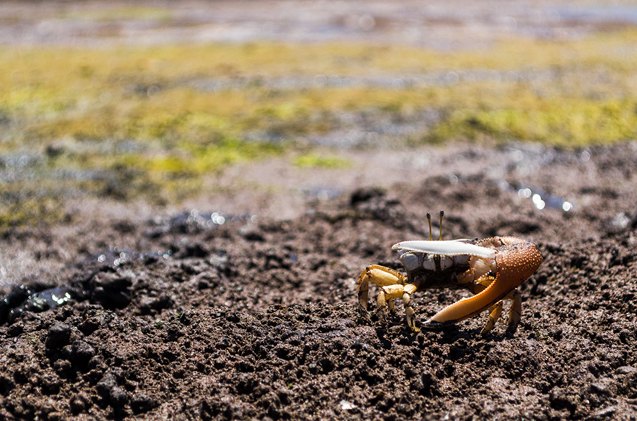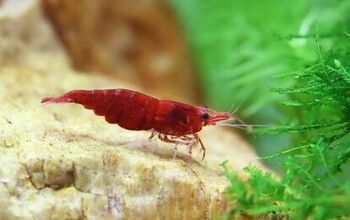Are You Feelin’ Crabby?

Have you ever wanted to try saltwater but were afraid of the work and expense, or just overwhelmed by the task? That’s how I’d always been. However, having a child in the 4th grade who brought me home an “Adoption request” paper for fiddler crabs, it was a chance to dally in the world of salt water. With 14 tanks of my own, I could hardly say no to her request to bring home these little creatures. I signed the form, and the following week she brought home four fiddler crabs, along with minimal knowledge and direction from her teacher on what to do with them.
I took to the Internet and managed pick up a decent idea of how to care for the crabs. We set up a 10 gallon tank for our four new friends, complete with play sand gently that sloped into a few inches of salt water. The next day, we learned the hard way a crucial piece of information – crabs don’t appreciate cold water. Two of the four died, and I had to figure out how to rig up a heater in the few inches of water so the other two wouldn’t leave us for Davey Jones’ locker. By learning from my mistakes, I’ve picked up a general working of fiddler crabs. I’m still learning as I go along, but you can learn from my mistakes.
Related: Anatomy of a Fish
Habitat
Fiddler crabs need to have a habitat that is partially salt water and partially substrate – particularly sand – to survive. If the water is too deep, they’ll drown, and the water needs to have a specific gravity of 1.005 to 1.010. You can measure the gravity this with a handy little tool called a hydrometer. In terms of warmth, water should be between 75-85 degrees Fahrenheit. This was where we made our first mistake, as I was uneasy about having a heater in such little water, especially in a tank that’s located in my child’s bedroom (tank explosions can happen). Once we corrected the water temperature, the crabs seemed a lot happier and more active. I also put a desk lamp over the sand portion of the habitat to warm it as well. We added a few snail and sea shells, and we bought them a hidey hut for them as well. The care-sheet instructions from the teacher said we needed to filter the water. But with such a small amount in the tank – probably less than a gallon – I wasn’t sure how to manage this at first. We settled on an air stone and plan to change the water frequently. I’ll report back with my finding on how often this should be done.
Related: Fish Ponds Let You Take Your Hobby Outside
Diet
The crabby care sheet was also vague on the diet of these critters, listing only plankton as a food source. I purchased a crab specific food from an online store, and they seem to enjoy it, although I’m sure they would appreciate some type of fresh or live food as well. Sigh… more research!
Sexing
I learned from my daughter that the male fiddlers have the larger claw. Of the initial four she brought home, one was male, but he didn’t survive his first night in Casa de Davis. Thanks to my smarty-pants daughter, I learned that females have two smaller claws, and if a crab loses a claw, it will grow back.
Overall, once the habitat was set up, I found that fiddler crabs aren’t terribly difficult to care for. The initial work, however, is enough. My main complaint was a nine year old was sent home with minimal information about the animals. Parents will need to make the time to research and create a suitable home for the animals, or else the crabs won’t survive. My journey to learn more about fiddler crabs will continue, as will the dedication to teach my child that every creature matters, no matter how small they are (or how crabby I am with all the research and set up I had to do!).
Summer Davis is the mom of three kids, four dogs, and several tanks of fish. She boasts a passion for all animals, whether they are in the water or on land. This fish aficionado has kept many different species in her time, but holds a special place in her heart for wild and domestic bettas. When she’s not talking about fish, Summer “spins” her extra time as the director of a baton twirling organization.

Summer Davis is the mom of three kids, four dogs, and several tanks of fish. She boasts a passion for all animals, whether they are in the water or on land. This fish aficionado has kept many different species in her time, but holds a special place in her heart for wild and domestic bettas. When she's not talking about fish, Summer "spins" her extra time as the director of a baton twirling organization."
More by Summer Davis
























